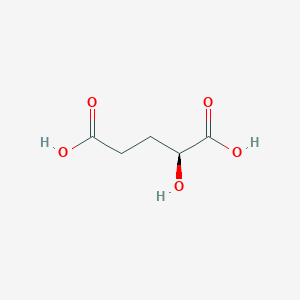|
L-2-Hydroxyglutaric acid is a metabolite that accumulates in L-2-hydroxyglutaric aciduria, which is a neurometabolic disorder (OMIM: 236792), and has been reported in multiple patients who have a clinical phenotype of progressive neurodegeneration with extrapyramidal and cerebellar signs, seizures, and spongiform changes in the white matter (OMIM: 600721). In humans, 2-hydroxyglutarate is formed by a hydroxyacid-oxoacid transhydrogenase whereas in bacteria it is formed by a 2-hydroxyglutarate synthase. L-2-Hydroxyglutaric acid can be converted to alpha-ketoglutaric acid through the action of 2-hydroxyglutarate dehydrogenase (EC 1.1.99.2). In humans, there are two such enzymes (D2HGDH and L2HGDH). Both the D and L stereoisomers of hydroxyglutaric acid are found in body fluids. L-2-Hydroxyglutaric acid can also be produced via gain-of-function mutations in the cytosolic and mitochondrial isoforms of isocitrate dehydrogenase (IDH). IDH is part of the TCA cycle and this compound is generated in high abundance when IDH is mutated. Since L-2-hydroxyglutaric acid is sufficiently similar in structure to 2-oxoglutarate (2OG), it is able to inhibit a range of 2OG-dependent dioxygenases, including histone lysine demethylases (KDMs) and members of the ten-eleven translocation (TET) family of 5-methylcytosine (5mC) hydroxylases. This inhibitory effect leads to alterations in the hypoxia-inducible factor (HIF)-mediated hypoxic response and alterations in gene expression through global epigenetic remodeling. The net effect is that L-2-hydroxyglutaric acid causes a cascading effect that leads genetic perturbations and malignant transformation. Depending on the circumstances, L-2-hydroxyglutaric acid can function as an oncometabolite, a neurotoxin, an acidogen, and a metabotoxin. An oncometabolite is a compound that promotes tumour growth and survival. A neurotoxin is compound that is toxic to neurons or neural tissue. An acidogen is an acidic compound that induces acidosis, which has multiple adverse effects on many organ systems. A metabotoxin is an endogenously produced metabolite that causes adverse health effects at chronically high levels. As an oncometabolite, L-2-hydroxyglutaric acid is a competitive inhibitor of multiple alpha-ketoglutarate-dependent dioxygenases, including histone demethylases and the TET family of 5mC hydroxylases. As a result, high levels of 2-hydroxyglutarate lead to genome-wide histone and DNA methylation alterations, which in turn lead to mutations that ultimately cause cancer. As a neurotoxin, L-2-hydroxyglutaric acid mediates its neurotoxicity through activation of N-methyl-D-aspartate receptors. L-2-Hydroxyglutaric acid is structurally similar to the excitatory amino acid glutamate and stimulates neurodegeneration by mechanisms similar to glutamate, NMDA, or mitochondrial toxins. As an acidogen, L-2-hydroxyglutaric acid is classified as an alpha hydroxy acid belonging to the general class of compounds known as organic acids. Chronically high levels of L-2-hydroxyglutaric acid are characteristic of the inborn error of metabolism called L-2-hydroxyglutaric aciduria. Abnormally high levels of organic acids in the blood (organic acidemia), urine (organic aciduria), the brain, and other tissues lead to general metabolic acidosis. Acidosis typically occurs when arterial pH falls below 7.35. In infants with acidosis, the initial symptoms include poor feeding, vomiting, loss of appetite, weak muscle tone (hypotonia), and lack of energy (lethargy). These can progress to heart abnormalities, kidney abnormalities, liver damage, seizures, coma, and possibly death. These are the symptoms typical of untreated L-2-hydroxyglutaric aciduria. Many affected children with organic acidemias experience intellectual disability or delayed development. In adults, acidosis or acidemia is characterized by headaches, confusion, feeling tired, tremors, sleepiness, and seizures.
|
 click to show the details of this protein
click to show the details of this protein
 click to show the details of experiment for validating this pair
click to show the details of experiment for validating this pair

